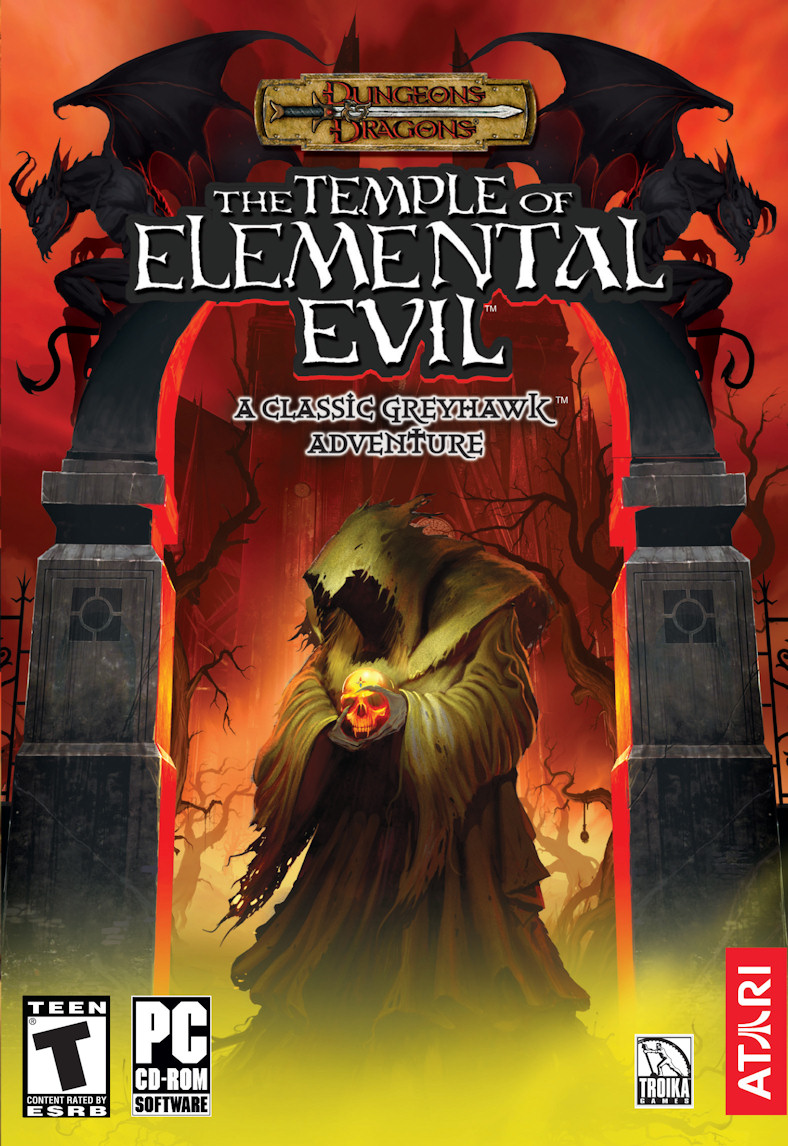The Temple of Elemental Evil Review
Article Index
Page 1 of 3
I'll say this outright. I've played many computerized and PnP RPGs over the years, but it's seldom I've encountered one whose good and bad qualities were as distinctive as TOEE. Depending upon what aspects of RPG gaming are individually rated the most significant, it's likely that this title will attract extreme reactions from players, Please bear this in mind while I attempt to explain what I find positive and negative about the game. You may come away with completely different conclusions than I have about any aspect of TOEE. But I hope you will extend me the courtesy of belief when I say that I've thoroughly played it, and without preconceptions concerning its quality. I have my own standards for what I expect from a computerized RPG, but I didn't approach this product either with guns blazing, or in an effort to sing the pre-printed praise of public relations.TOEE belongs to that family of RPGs that lets you create an entire party, rather than focusing on one character and acquiring others as you travel. The creation screens let you design and maintain a raft of individual characters, rather than a single party with fixed members. You can use the point buy system for ability stats (the usual Strength, Dexterity, Constitution, Intelligence, Wisdom and Charisma), or roll up a character. The latter offers an excellent chance of getting more stat points and higher scores, which you can distribute at will among your different abilities. Eleven classes (including monks) are available, and seven races (including half-orcs): no surprises, there. Feats, skills, spells, portraits: again, these are all basically familiar, if you've played recent RPGs such as Icewind Dale 2. If you haven't, however, you'll want to consider carefully what feats you give your party members, since they can only reach 10th level in TOEE. It's an understandable limitation in the game, designed to properly scale combat and keep godlike parties from developing, but it does put those few feats some of your characters get at premium value.
Alignment is also important during TOEE's character creation. It limits the selection of characters you can have in your party; so that a Neutral Good group can only contain that alignment and adjacent ones: Lawful and Chaotic Good, and True Neutral. This determines where your party starts up and the selection of quests you receive. In all honesty, though, some of the changes were merely cosmetic, a matter of being sent to the same area and fighting the same monsters for different reasons. Some quests are only available to some alignments, however, and the game length could vary widely, as a result. Once in the TOEE module, alignment has no effect, at all. You aren't faced with moral dilemmas and dialog/action choices whose outcomes can shift this factor.
TOEE employs a hybrid system of 2D backgrounds and 3D foreground figures. The backgrounds resemble many other third party RPGs over the recent years, in particular the IWD and BG series: they're pleasantly drawn without stirring much enthusiasm. As much can be said for the portraits that appear when you speak with NPCs, though I'm glad these were added to the game. Troika's last title, Arcanum, lacked portraits save for you and your followers.
It's those foreground party figures that are so much more appealing. You can actually watch smaller races peddle those little legs faster to keep up; and unless it's my imagination, they actually take longer to arrive at any destination you choose. (The location marker you plant on the background, signaling a movement to your party, also takes the form of six circles, sized according to your respective party members: a small but nice touch.) Animation of all figures, your party members in particular, is excellent, while animation of magical effects in general is spectacular. It's safe to say that after seeing the way Magic Missiles arch along their extended trajectories in TOEE, you'll never be able to accept the way they've appeared in any previous game, again. Not everybody in the RPG development community wants to go the complete 3D route for multiple character parties, as Bioware did in KotoR; and for them, TOEE points to a viable, attractive alternative. It may just extend the life of the 2D RPG engine for a few more years.
Praise is due as well for the ability to give each party member up to four different configurations of weapons, armor and items, which are stored in memory. Character images are linked to their paper dolls, so changes you make to a character's appearance are accurately reflected in the game world.
On the downside, the game looks dark with my current card, an admittedly ancient (by current standards) ATI Radeon. This is especially so with interiors. If your video card lacks a gamma/brightness control, you're out of luck, at least, for now, since game options include no way to brighten the product. One would think Troika ought to know enough to include this. After all, it was in the initial release of their last title, Arcanum.
In addition, for all its wealth of animated detail, TOEE actually contains far less background that's interactive than several other recent RPG releases, such as Divine Divinity or Icewind Dale 2. It's so much like wallpaper, in fact, that it's easy to miss the very occasional times when an object (such as a cabinet) truly functions as a container.


